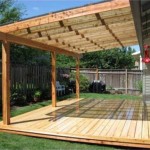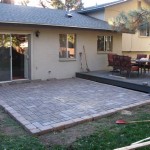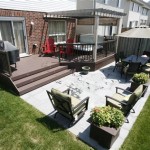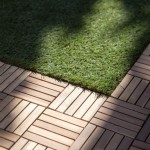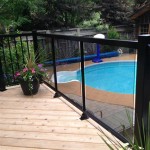How To Fix Unlevel Concrete Patio
An unlevel concrete patio presents a significant aesthetic and practical problem for homeowners. Beyond the visual disruption, uneven surfaces can create tripping hazards, hinder furniture placement, and accelerate the deterioration of the concrete itself. Addressing these issues promptly and effectively requires a methodical approach, combining accurate assessment, proper material selection, and precise execution. This article details several techniques for leveling a concrete patio, outlining the steps involved and considerations for each method.
Before commencing any repair work, a thorough assessment of the problem is crucial. This involves identifying the extent of the unevenness, determining the underlying cause, and evaluating the overall condition of the concrete slab. Minor settlements, often resulting from soil compaction or erosion, can be addressed with relatively simple leveling techniques. However, more severe displacement, potentially stemming from expansive soil, tree root intrusion, or structural damage, may necessitate more extensive repairs or even complete replacement.
The tools and materials required will vary depending on the chosen leveling method. However, some common essentials include a level (ranging from a standard bubble level to a laser level for greater accuracy), measuring tape, marking chalk or paint, a concrete grinder or patching compound (depending on the approach), a trowel, a concrete mixer (if applying a new layer of concrete), and personal protective equipment (PPE) such as safety glasses, gloves, and a dust mask.
Understanding the Causes of Unlevel Concrete Patios
Diagnosing the root cause of the uneven patio is paramount to implementing a long-term solution. Addressing only the symptom (the uneven surface) without tackling the underlying problem will likely lead to a recurrence of the issue. Common causes include:
Soil Settlement and Compaction: Over time, the soil beneath the concrete slab can settle or compact, particularly in areas with poor drainage or unstable soil composition. This settlement creates voids under the slab, leading to uneven sinking.
Erosion: Water runoff can erode the soil beneath the patio, especially if the patio is not properly sloped or if drainage systems are inadequate. This erosion can create voids similar to those caused by settlement.
Expansive Soil: Certain types of soil, such as clay, expand and contract significantly with changes in moisture content. This expansion and contraction can exert considerable pressure on the concrete slab, causing it to heave or crack, resulting in an uneven surface.
Tree Root Intrusion: Tree roots growing beneath or near the patio can lift and displace the concrete slabs as they expand. This is a common problem in older patios located near mature trees.
Improper Installation: A poorly prepared base, inadequate concrete thickness, or insufficient reinforcement during the initial construction can lead to premature cracking and settling, ultimately resulting in an unlevel patio.
Frost Heave: In colder climates, the freeze-thaw cycle can cause the soil to expand and contract, leading to concrete displacement. This is particularly problematic if the patio lacks proper drainage and insulation.
Once the cause is identified, the appropriate repair method can be selected. The following methods offer solutions for various degrees of unevenness and underlying problems.
Methods for Leveling a Concrete Patio
Several methods exist for addressing an unlevel concrete patio, each suited to different degrees of unevenness and underlying causes. The method selected should be based on a careful assessment of the problem and the desired outcome.
Self-Leveling Concrete Overlay: This method is suitable for correcting minor to moderate unevenness across a larger area. Self-leveling concrete is a pourable mixture that spreads evenly across the existing surface, filling low spots and creating a new, level plane. This approach is typically used when the existing concrete is structurally sound but exhibits surface imperfections.
Procedure:
1. Surface Preparation: Thoroughly clean the existing concrete surface by removing any debris, dirt, oil, or loose particles. Pressure washing is often recommended. Acid etching or mechanical abrasion (grinding) may be necessary to create a porous surface that promotes proper bonding of the self-leveling compound.
2. Priming: Apply a concrete primer to the prepared surface according to the manufacturer's instructions. This primer enhances adhesion and prevents the self-leveling compound from drying out too quickly.
3. Mixing: Carefully mix the self-leveling concrete according to the manufacturer's specifications. Proper water-to-powder ratio is crucial for achieving the desired consistency and flow characteristics.
4. Pouring and Spreading: Pour the self-leveling concrete onto the patio, starting at the lowest point. Use a gauge rake or trowel to spread the mixture evenly and ensure it covers the entire area. The self-leveling properties of the compound will help it flow into low spots and create a level surface.
5. De-airing: Use a spiked roller to remove any trapped air bubbles from the self-leveling concrete. This ensures a smooth and durable finish.
6. Curing: Allow the self-leveling concrete to cure according to the manufacturer's instructions. This typically involves keeping the surface damp for several days to prevent cracking.
Concrete Grinding: For localized high spots or minor unevenness, concrete grinding can be an effective solution. This involves using a concrete grinder with a diamond grinding wheel to remove material from the high spots, creating a smoother and more level surface. This method is suitable for small areas and requires careful control to avoid over-grinding.
Procedure:
1. Marking: Identify and mark the high spots on the patio using chalk or paint.
2. Grinding: Using a concrete grinder with a diamond grinding wheel, carefully grind down the marked high spots. Apply consistent pressure and move the grinder in a sweeping motion to avoid creating gouges or uneven surfaces.
3. Checking Level: Periodically check the level using a level and straight edge to ensure that the high spots are being effectively removed and the surface is becoming more level.
4. Dust Control: Concrete grinding generates a significant amount of dust. Use a vacuum attachment on the grinder or wet-grinding techniques to minimize dust dispersion. Always wear a dust mask and safety glasses.
5. Finishing: After grinding, clean the surface thoroughly and apply a concrete sealer to protect the exposed concrete.
Mudjacking (Slab Jacking): This method is used to lift sunken concrete slabs back to their original level. It involves injecting a slurry of cement, sand, and other additives beneath the slab to fill voids and raise it. Mudjacking is a cost-effective option for addressing significant settlement issues without replacing the entire patio.
Procedure:
1. Drilling: Small holes are drilled through the concrete slab at strategic locations.
2. Injection: A slurry mixture is injected through the holes under pressure. The pressure lifts the slab back to its original level.
3. Monitoring: The lifting process is carefully monitored to ensure that the slab is raised evenly and without cracking.
4. Patching: The drilled holes are patched with concrete or a compatible patching compound.
5. Sealing: The patched areas are sealed to prevent water penetration and protect the repair.
Slab Replacement: In cases of severe damage, extensive cracking, or significant displacement, replacing the entire concrete slab may be the most practical solution. This involves removing the existing slab and pouring a new one. While more expensive and time-consuming than other methods, slab replacement ensures a structurally sound and aesthetically pleasing patio.
Procedure:
1. Demolition: The existing concrete slab is broken up and removed. Heavy machinery may be required for larger patios.
2. Base Preparation: The base beneath the old slab is inspected and properly prepared. This may involve compacting the soil, adding gravel for drainage, and installing a sub-base of compacted aggregate.
3. Forming: Forms are constructed to define the perimeter of the new concrete slab.
4. Reinforcement: Reinforcing steel (rebar or wire mesh) is installed within the forms to provide structural support and prevent cracking.
5. Pouring: Concrete is poured into the forms and spread evenly. The surface is leveled and smoothed using a screed and trowel.
6. Finishing: The concrete surface is finished to the desired texture. This may involve brushing, texturing, or applying a decorative finish.
7. Curing: The concrete is cured according to industry standards. This typically involves keeping the surface damp for several days to prevent cracking.
Preventative Measures for Maintaining a Level Concrete Patio
Once the patio has been leveled, implementing preventative measures is crucial to maintaining its condition and preventing future unevenness. These measures focus on addressing the underlying causes and protecting the concrete slab from damage.
Proper Drainage: Ensure that the patio has adequate drainage to prevent water from accumulating beneath the slab. This may involve sloping the patio away from the house, installing drainage pipes, or improving the surrounding landscaping to direct water away from the patio area.
Soil Stabilization: Stabilize the soil around the patio to prevent settlement and erosion. This can be achieved through the use of retaining walls, soil compaction, or the addition of soil amendments to improve drainage and stability.
Tree Root Management: If tree roots are a potential problem, consider installing root barriers to redirect root growth away from the patio. Regularly prune trees to control their root systems and prevent them from encroaching on the patio area.
Sealing: Apply a concrete sealer to the patio surface to protect it from water penetration, stains, and freeze-thaw damage. Reapply the sealer every few years to maintain its effectiveness.
Regular Inspection: Regularly inspect the patio for signs of cracking, settlement, or other damage. Addressing these issues promptly can prevent them from escalating into more significant problems.
Load Management: Avoid placing excessive weight on the patio, as this can contribute to settlement and cracking. Distribute heavy loads evenly and consider using pavers or other materials to support heavy objects.
By understanding the causes of unlevel concrete patios, selecting the appropriate repair method, and implementing preventative measures, homeowners can effectively address uneven surfaces and ensure the longevity and aesthetic appeal of their outdoor living spaces. If unsure about any aspects of the repair process, consulting with a qualified concrete contractor is always recommended.

Repair Uneven Concrete With Perma Seal S Polylevel

How To Fix Uneven Concrete Slabs 5 Options

How To Fix Uneven Concrete Slabs

Repair Uneven Concrete With Perma Seal S Polylevel

Repair Uneven Concrete

Avoid Safety Hazards Fix Ed Uneven Concrete Now

How To Repair A Trip Hazard

Lowering Raised Concrete How To Lower Slabs

Dealing With Sunken And Ed Concrete In Barrington Lake Zurich Hero Leveling Coatings

An Easy Way To Fix Sinking Concrete
Related Posts

